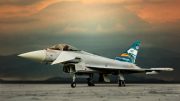| The Airbus Zephyr, Solar High Altitude Platform Station (HAPS) concludes a successful new test flight campaign in Arizona, USA Farnborough, 3 December 2020 – Airbus Defence and Space has successfully completed a new test flight campaign for its Zephyr High Altitude Platform Station (HAPS) in Arizona, U.S.A. The 2020 flight campaign succeeded despite global slowdowns due to the Covid19 pandemic. It focused on aircraft agility, control and operations to build upon previous campaigns, which have already proven the day and night stratospheric persistence of the unmanned aerial system (UAS) essential in military and commercial markets. This year’s campaign held during the first three weeks of November aimed to demonstrate operational flexibility and aircraft agility, particularly testing lower altitude flying and early stage transition to the stratosphere. It also allowed the validation of a new flight planning tool suite and the development of operational concepts through multiple, varied flights in short succession. “Having proven stratospheric flight, we continue to further mature the operational system with the objective to be more flexible and robust in order to meet our customer needs. The outcome of this campaign is a valuable contribution to the full flight programme next year,” said Jana Rosenmann, Head of Unmanned Aerial Systems at Airbus. The campaign team used a Zephyr aircraft, fitted with new software control systems and specific flight test instruments, plus associated lighter test aircraft to conduct multiple successful test flights during November. The flights demonstrated take-off, climb, cruise, upgraded flight control and descent phases, followed by successful landings. The objectives of the test campaign were all achieved showcasing a more resilient and capable aircraft. Zephyr is the world’s leading, solar–electric, stratospheric Unmanned Aerial System (UAS). It harnesses the sun’s rays, running exclusively on solar power, above the weather and conventional air traffic, filling a capability gap complementary to satellites, UAVs and manned aircraft to provide persistent local satellite-like services. With the conclusion of this year’s successful test flight campaign, Zephyr has come another step closer to an operational reality. Zephyr will bring new see, sense and connect capabilities to both commercial and military customers alike. Zephyr will provide the potential to revolutionize disaster management, including monitoring the spread of wildfires or oil spills. It provides persistent surveillance, tracing the world’s changing environmental landscape and will be able to provide communications to the most unconnected parts of the world. Already in July 2018, the Zephyr team conducted a successful test flight campaign when Zephyr S flew in the stratosphere for nearly 26 days (25 days, 23 hours and 57 minutes). It remains the longest flight duration of an aircraft ever made without refuelling. The aircraft persisted in the stratosphere day and night, consistently achieved a dawn altitude of 60,000ft as well as its highest altitude of 71,140ft. |
| About the Airbus Zephyr Programme: The original target mission of the Zephyr is to provide local persistence at an affordable price with a re-usable solar-powered aircraft, providing a wide scope of applications, ranging for example from maritime surveillance and services, border patrol missions, communications, forest fire detection and monitoring, or navigation. Operating in the stratosphere at an average altitude of 70,000 feet / 21 kilometres, the ultra-lightweight Zephyr has a wingspan of 25 meters and a weigh of less than 75kg, and flies above weather (clouds, jet streams) and above regular air traffic, covering local or regional footprints. Ideally suited for “local persistence” (ISR/Intelligence, Surveillance & Reconnaissance), the Zephyr has the ability to stay focused on a specific area of interest (which can be hundreds of miles wide) while providing it with satellite-like communications and Earth observation services (with greater image granularity) over long periods of time without interruption. |
| About Airbus Airbus is a global leader in aeronautics, space and related services. In 2019, it generated revenues of € 70 billion and employed a workforce of around 135,000. Airbus offers the most comprehensive range of passenger airliners. Airbus is also a European leader providing tanker, combat, transport and mission aircraft, as well as one of the world’s leading space companies. In helicopters, Airbus provides the most efficient civil and military rotorcraft solutions worldwide. |
Source: Airbus








Be the first to comment on "A successful new test flight campaign in Arizona"